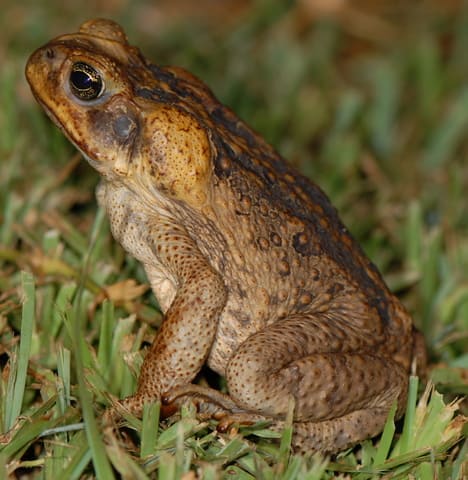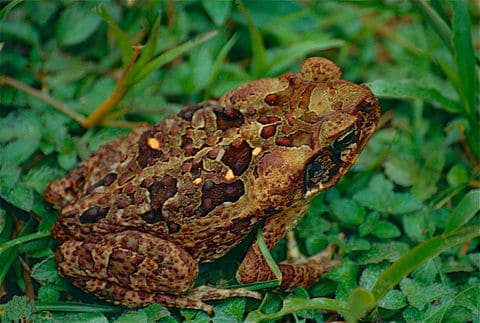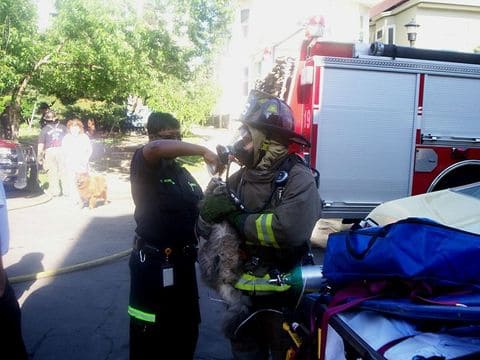For my own personal use only:
- Toad poisoning
- Classic case: Affects CNS and cardiovascular
system

- Dogs affected most, sometimes cats
- Variable presentation
- Oral irritation, frothing and pawing at mouth
- Retching
- Vomiting
- Cyanosis
- Cardiac arrhythmias
- Seizures
- DEATH
- Dx: History of exposure
- Toxic principles:
- Bufagenins
- Act like digitalis
- Bufotoxins
- Act like local anesthetics, catecholamines, serotonin
- Block sodium channel in nerves
- Toxic principles:
- Rx: Thoroughly rinse mouth and ...
- Treat any cardiac arrhythmias and give digoxin-specific antibody if refractory
- Decrease salivation: Atropine if normal cardiac rhythm
- CNS excitability: Benzodiazepines
- Cyanosis: Oxygen therapy
- Pearls:
- See most often in warm weather
- Rhinella marina (formerly Bufo marinus):
Giant
or marine toad
- This is most toxic toad in US
- Found mostly in Florida, Texas, and Hawaii
- Potency and type of toxin vary with type of toad
- Classic case: Affects CNS and cardiovascular
system
- Insecticides (organophosphates, carbamates, organochlorines, pyrethrins)
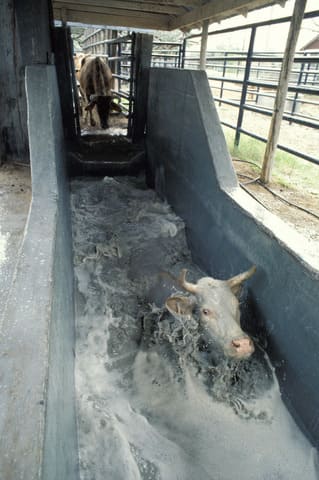
Cattle going through a tick treatment bath 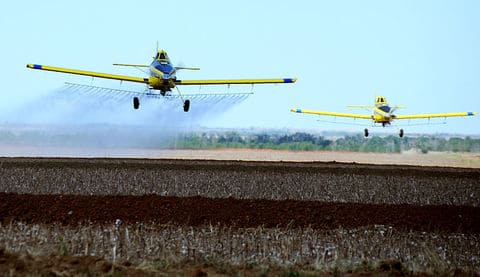
Accidental toxic-level exposure may occur when insecticides are applied to fields using crop dusters - Classic case: All species affected

- Organophosphates and carbamates: Affect all systems,
especially gastrointestinal, neuromuscular, CNS
- Muscarinic: SLUD
- Salivation
- Lacrimation
- Urination
- Diarrhea
- Nicotinic:
- Muscle tremors
- Weakness
- Central:
- Anxiety
- Ataxia
- Seizures
- Respiratory failure
- Organochlorines: Affect CNS
- Abnormal behavior, posture
- Vocalization
- Neuromuscular tremors, convulsions
- Hyperthermia
- Pyrethrins/pyrethroids: Affect CNS
- Tremors, seizures
- Incoordination
- Hunched back
- Salivation
- Death
- Organophosphates and carbamates: Affect all systems,
especially gastrointestinal, neuromuscular, CNS
- Dx: History, clinical signs, and ...
- Organophosphates:
- Measure acetylcholinesterase concentration in blood and brain (usually a 70% or more decrease)
- Measure organophosphates in stomach/rumen, blood/serum, urine
- Carbamates:
- Measure acetylcholinesterase concentration in blood and brain (usually a 50% or more decrease)
- Measure carbamates in stomach/rumen, blood/serum, urine
- Organochlorines:
- Measure organochlorines in brain/liver/kidney/fat/stomach
- Check blood/urine in rest of herd/flock
- Pyrethrins/pyrethroids:
- Measure pyrethrins/pyrethroids in tissues/fluids
- Organophosphates:
- Rx:
- Organophosphates:
- Decontamination (gastric emesis/lavage, activated charcoal)
- Atropine (anti-muscarinic)
- 2-pyridine aldoxime methochloride (2-PAM)
- Diazepam for seizures
- Do NOT give phenothiazines as they potentiate organophosphate
- Carbamates:
- Decontamination
- Atropine (anti-muscarinic)
- Do NOT use 2-PAM as it can also reversibly bind and inhibit acetylcholinesterase and therefore may exacerbate the clinical signs
- Organochlorines:
- Bathe if dermal exposure
- Decontamination
- Reduce stress
- Barbiturates or diazepam
- Pyrethrins/pyrethroids:
- Bathe if dermal exposure
- Activated charcoal
- Do NOT induce emesis because the petroleum solvent may cause aspiration pneumonia
- Barbiturates or diazepam
- Organophosphates:
- Pearls:
- Organophosphates:
- Pathophysiology:
- Irreversibly inactivates acetylcholinesterase at synapses and in erythrocytes
- Newer organophosphates are less toxic because they require hepatic activation
- Frequent toxicosis due to narrow margin of safety
- Carbamates:
- Pathophysiology:
- Reversibly inactivates acetylcholine at synapses and in erythrocytes
- Considered safer than organophosphates so used more often
- Organochlorines:
- Pathophysiology: CNS stimulation
- Rarely used because of tissue residues and chronic toxicity
- Pyrethrins/pyrethroids:
- Pathophysiology:
- Affect sodium, chloride, and calcium channels
- Affect nicotinic acetycholine receptors
- Pyrethrins are from the plant C. cinerariaefolium
- Pyrethroids are synthetic derivatives of pyrethrins
- Organophosphates:
- Classic case: All species affected
- Petroleum products
-
Classic case: Acute onset, 1-3 h after exposure, look for respiratory, GI, and dermatologic signs

- Seen mostly in dogs, cats (less common than dogs), or ruminants, but all species are vulnerable
- All species:
- Dyspnea/aspiration pneumonia
- DEATH
- Small animals:
- Oral exposure: Hypersalivation, vomiting, retching
- Dermal exposure: Inflamed/irritated interdigital skin on feet, smell of product on coat
- Ruminants: Bloat
- Dx:
- Toxic principle: Volatile hydrocarbons
- Odor of hydrocarbons from lungs/rumen contents/feces
- Rx:
- Small animals:
- Do NOT administer activated charcoal or induce emesis because of aspiration risk
- Respiratory support: e.g., supplemental oxygen, mechanical ventilation if severe
- Dermal exposure: Gently bathe affected areas using dishwashing liquid
- Administer analgesics to address pain associated w/ dermal lesions
- Ruminants: Rumenotomy to remove gastric contents or relieve bloat with stomach tube (risk of aspiration) or trocar (risk of peritonitis)
- Small animals:
- Pearls:
- Pathophysiology:
- Chemical aspiration pneumonia: Low viscosity and high volatility (e.g., gasoline, kerosene) increase aspiration risk
- Prognosis good unless aspiration pneumonia
- Dogs and cats may ingest petroleum products when grooming
- Cows may ingest because curious or thirsty
- Pathophysiology:
- Smoke inhalation
- Classic case: Affects respiratory system

- All species can be affected, but worse in smaller animals and birds
- 12-48 h after inhalation (compromise peaks at 12-24 h
post-inhalation):
- Coughing
- Stridor, tachypnea, dyspnea
- Voice change, lower respiratory noise
- If inhaled toxicants:
- Depression, weakness
- Obtundation, coma
- Dx:
- Several toxic principles (examples):
- Carbon monoxide
- Cyanide gas
- Methane
- Sulfur trioxide
- Pyrolysis products (cause polymer fume fever)
- Laryngoscopy/bronchoscopy (gold standard): See edema, ulceration, subglottic injury
- Pulse oximetry: Carboxyhemoglobin and methemoglobin will cause false high readings
- Pulse co-oximetry is usually more accurate than pulse oximetry
- Arterial blood gases (PaO2 is not affected by carbon monoxide poisoning)
- Elevated carboxyhemoglobin concentration (although may be falsely decreased if recent oxygen treatment)
- Elevated lactate concentration (especially with cyanide gas poisoning)
- CBC: Decreased PCV and hemoglobin after 1 wk
- Thoracic imaging: See changes (atelectasis, pulmonary edema, hyperinflation) at 24-36 h
- ECG: Compatible with cardiac ischemia (S-T segment elevation or depression, T-wave inversion)
- Several toxic principles (examples):
- Rx:
- Intubation or tracheostomy and administer oxygen
- Specific Rx:
- Methemoglobinemia: Methylene blue
- Polymer fume fever: Acetylcysteine
- Bronchodilators
- +/- Antibiotics, corticosteroids
- Pearls:
- Pathophysiology due to thermal injury and inhaled
toxicants
- Steam produces severe lung injury
- Pathophysiology due to thermal injury and inhaled
toxicants
- Classic case: Affects respiratory system
- Strychnine
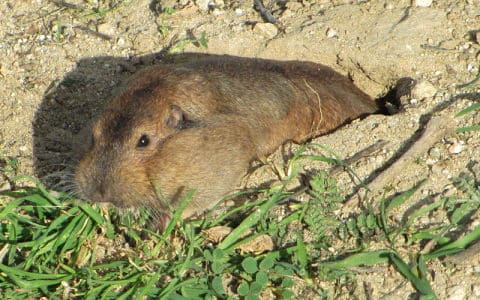
Strychnine is mostly used as gopher bait 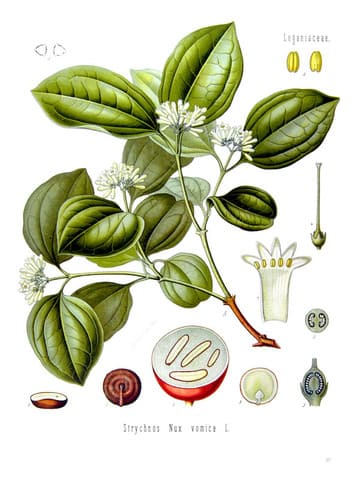
Strychnos nux-vomica plant that produces the toxic seeds 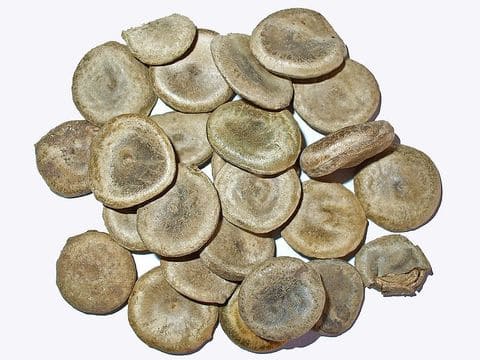
Strychnos nux-vomica seeds - Classic case: Affects CNS

- All species vulnerable, but most often in western USA in young, large-breed, intact male dogs
- Initially:
- Nervous
- Stiff
- Very rapid progression
- Generalized rigidity
- Tetanic spasms
- Tonic-clonic seizures
- Hyperthermia
- DEATH
- Dx:
- Toxic principle: Indole alkaloid
- Measure strychnine in stomach contents, liver, kidney, urine
- Rx:
- Decontamination
- Control seizures: Pentobarbital, methocarbamol
- Prevent asphyxiation: +/- Intubation and artificial respiration
- Pearls:
- Strychnine comes from the seeds of the Indian tree Strychnos nux-vomica
- Pathophysiology:
- Competitive and reversible inhibition of the inhibitory neurotransmitter glycine at postsynaptic sites in spinal cord and medulla
- Striated muscle rigidity
- Used in gopher bait
- Restricted use pesticide because so highly toxic
- Classic case: Affects CNS
-
Classic case: Acute onset, 1-3 h after exposure, look for respiratory, GI, and dermatologic signs
Images courtesy of Sam Fraser-Smith (top marine toad), Bernard DUPONT (bottom marine toad), Wutsje (vomiting cat), Scott Bauer (dipping cows), Airman 1st Class Kenneth Norman (cropdusters), John (diesel spill), Dragonfire1024 (cat receiving oxygen), National Park Service (sage fire), Davefoc (gopher), H. Zell (strychnine seeds), Franz Eugen Köhler (strychnine plant), and Hisashi (cat licking paw) .
Top Topic Category
Cross-Species
